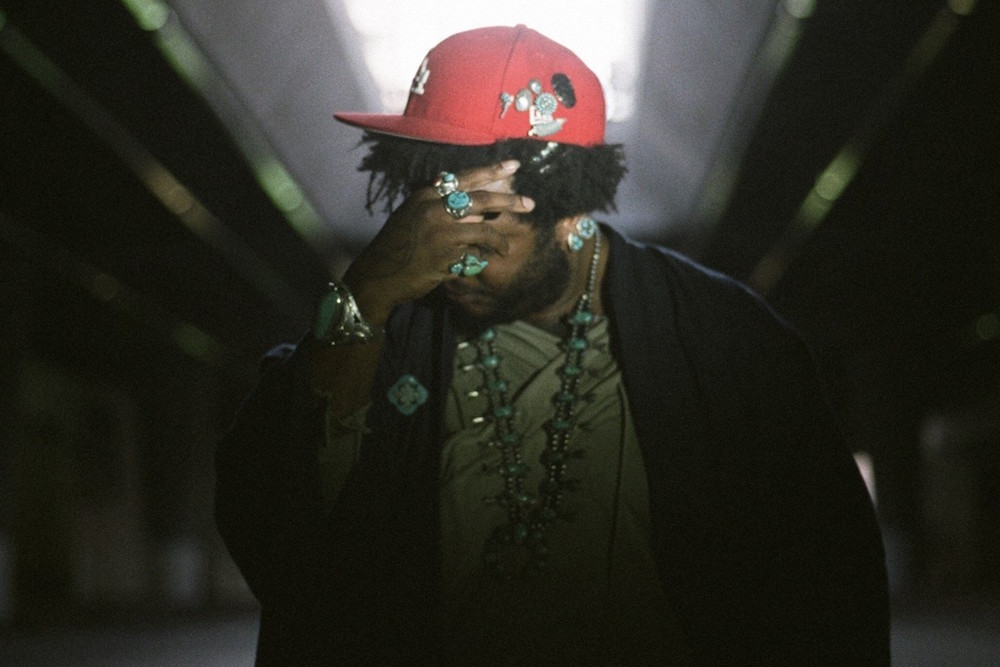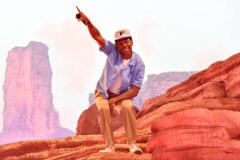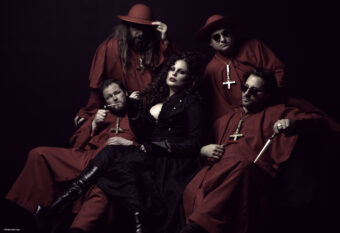32-year-old starcrosser Stephen Bruner—a.k.a. Thundercat—has the relatable surrealism of a George Clinton who lives next door. His kaleidoscopic output threads together the influences of jazz and funk Svengalis, while his lyrics often focus on the flesh’s daily pleasures and limitations. He was featured prominently on Flying Lotus‘ 2014 album about death, but on his recently released opus Drunk he sounds reborn—kind of. On second track “Captain Stupido” he croons, “I feel weird, comb your beard, brush your teeth / Still feel weird, Beat your meat, go to sleep.”
Los Angeles, where Thundercat was born and raised, is known for having one of the nation’s most diverse music scenes, and in many ways, he is an amalgamation of the city’s taste. His portfolio over the past decade includes freak-out EDM dispatches, R&B voyages, and protest masterworks. Thundercat doesn’t only standout because of breadth, though. His bass work is both dexterous and injected with an everyman sort of genius, and his signature touch is immediately recognizable.
Thundercat’s career catapulted upwards fairly recently, thanks in part to his appearances on Flying Lotus’ 2010 astral odyssey Cosmogramma. But his increasingly rewarding run as a solo artist has been buttressed by his years as a supporting musician, starting with the legendary punk outfit Suicidal Tendencies and on through contributions to albums by Erykah Badu, Kendrick Lamar, and Childish Gambino. As multi-various as his portfolio is, Thundercat would argue none of the styles are too distant from his solo work, including his new album Drunk.
A few days before the LP’s release, Thundercat spoke with SPIN to tell the stories behind his collaborations, and to explain how it all weaves into his solo output.
Suicidal Tendencies
(2002-11)
I grew up playing jazz, but when I joined Suicidal—which was like my 10th grade year in high school—it was like a slingshot into the spotlight in a different way. I’m not the guy you would see in the pictures all the time, but it’s one of those things where I felt like I was in the band. Everything from the part where people are yelling, “You’re not [former bassist] Robert Trujillo,” somebody throwing a shoe at you, to all kinds of stuff like that.
I’ve grown up with jazz—the Joe Hendersons, Oliver Nelsons, Miles Davis and stuff—but I was also listening to like Slipknot, Korn and Rage Against the Machine. There was all of that weaved interweaved in there and being from L.A., you tend to know your musical history.
I felt like that’s who I was and it affected every part of what it meant for me to be an artist. I learned what it meant to stand up front and to be bold about what you do. From [lead vocalist] Mike Muir and [lead guitarist] Dean Pleasants. I wouldn’t be who I am today if it wasn’t for them. That does play a role in the artistry of me becoming Thundercat. Mike Muir would never call me Thundercat even though I would always wear a Thundercat shirt. Like it wasn’t like, “You’re gonna call me Thundercat.” That’s just what I wore.
The Golden Age of Apocalypse
(Thundercat, 2011)
I toured with [Suicidal Tendencies] through The Golden Age of the Apocalypse. I was still in the band until sometime into the second album when I had to stop playing with them because I couldn’t—my life was taking over and I had to make a change.
One thing I loved about playing in Suicidal was that Mike would let me play, he wouldn’t try to like shut me down. If it was time for me to take a bass solo, he would just walk off stage. And he would also leave me out there with the wolves, people would boo and stuff and anything could happen but it was just like, “Don’t just stand there man, you have to do something or someone’s gonna hit you with a shoe.” It emboldened me, and it definitely has a direct link to the playing part.
Erykah Badu
(New Amerykah Part One [4th World War], 2008; New Amerykah Part Two [Return of the Ankh], 2010)
Right before New Amerykah and she wanted to go further into hip-hop with the whole thing. I remember she would come to L.A. to record and I’d just be sitting there to make myself available to her. What came of it is what came of it: She was listening to tracks and there was one track that I did all by myself and she was like, “Well who did this one?” And they pointed to me and from that moment on, her and me became best friends.
She—more than Mike Muir, more than anybody else, taught me to be an artist. She held my hand through a lot of it. My mindset, my physical makeup for how things made sense, I developed it around Erykah. We walked very close for years—and we still do. I wouldn’t be who I am right now if it wasn’t for Erykah.
New Amerykah Pt. 1 is one of my favorite albums of hers. I remember it freaked everybody out because she got Madlib, Karriem Riggins, and Sa-Ra and everybody was like, “What is she doing?” It was a time capsule of hip-hop, like this thing that was looking forward and backwards and in the now, and that’s what New Amerykah was. And I think one of my favorites was—and she hates this song, too—was “Honey.” That’s a special song to me. I remember she would get all weird every time we played it, but it’s one of those things where it was cool.
Apocalypse
(Thundercat, 2013)
I’m going through emotions of digging for music and in the process of it I lost my closest friend. And I lost him in a tragic way: I was with him right before he died and it scarred me very heavily. The process of writing took a very dark turn and it couldn’t help but be interweaved in the whole entire music. By the end of the album, I could barely get the lyrics out—I was saying goodbye to my friend in real life.
That album is a very special album to me. Any time somebody buys the vinyl, I make it a point to talk to them about Austin [Peralta] and show the picture of him in the vinyl. Because he was a special dude. If he would have been here, you guys would have been tripping off him, too. He was a jazz monstrosity—like a little bit of Bill Evans and Kenny Kirkland mixed with Keith Jarrett. He was pretty bad, man.
Childish Gambino
(Because the Internet, 2013)
There’s so many terms that have been given to guys like him, like “triple-threat” or whatever you want to call it. But he’s amazing and the world sees that. I really look forward to working with him more in the future, but he’s just kicking everybody’s ass right now. He’s making everybody look like hobos. He’s the Lion King now, he’s got one of the coldest rap albums, and he just decided to put out a funk album that kicked everybody in the nuts.
Kendrick Lamar
(To Pimp a Butterfly, 2015)
Kendrick is an artist that speaks from the heart. For me personally, I feel like I gravitate toward those moments like that. And it’s not just speaking from the heart in a foolish manner. He’s very well-versed in who he is and what he does. And it was very much magnetic, because I vaguely remember the first session we did. He called me to play bass for something that we did—it wasn’t on good kid, m.A.A.d city or To Pimp a Butterfly, but he invited me. When he did “Swimming Pools,” it was a guy that was seeing further, because he didn’t drink. For me, I lost my mind to this song.
We would sit there and share life stories, experiences, and emotions, but we would be making music as it was going along with that. Sounwave would have different things and different ideas, and I would always have cartoons and random life to share with him. We would just sit there and trip out and cut the music up and sit there and make music and watch cartoons. And from those moments on my couch to the moments to when people hear “Mortal Man” and “King Kunta,” there was a symbiotic-ness between me, Sounwave, and Kendrick because it was just an open line of communication. No part of life was shut off and that’s what I think came through with that album—from the moment you hear “we gon’ be alright,” which for many would be the song that would kick off what we’re seeing right now, which is insane. In the thick of it, nobody sees it, but if you can see over the smoke, you see these defining moments in our culture that we’re catalysts for and we’re part of. To Pimp a Butterfly is for sure one of those moments.
I remember with Kendrick on To Pimp a Butterfly, I was in tears. I literally was because it had pulled me and pushed me and stretched me and crushed me and expanded me. It was like I didn’t know which way was up. By the end of it, I felt like I was floating in the ocean like a carcass.
The Beyond / Where the Giants Roam
(Thundercat, 2015)
Well again, like these were interweaved into each other’s fabric, everything from [Flying Lotus’s] You’re Dead! to The Epic with Kamasi Washington, to To Pimp a Butterfly to beyond, those things were all in the same breath. It felt like they were all three evolving around each other, as being created at the same time.
Flying Lotus
(Cosmogramma, 2010; Until the Quiet Comes, 2012; You’re Dead, 2014; WOKE – “The Lavishments of Light Looking” ft. George Clinton, 2015)
I feel like that’s something that’s really interestingly specific to me and him and kind of translated through the years with the music. But we just are kind of always in each other’s minds: I’m always wondering what is Lotus doing. I love the dude. Our girlfriends used to call us gay. Like, “You love the dude, why don’t y’all just date.” And it was like cheeky, but it was like, “Oh you’re just jealous because you’d rather figure things out.” But it’s one of those things where I’m constantly thinking of the guy and what he’s doing and what he’s up to. That’s how it’s been since the beginning. It’s always felt like we were doing some kind of ESP.
“Dance of the Pseudo Nymph” is probably my favorite song that we did together. There’s always these pictures where I’m wearing this Native American headdress, and I remember I used to wear that thing as part of my wardrobe on a regular basis. I remember recording that song and wearing that headdress and I remember it felt like we were calling on somebody or something else. It looked like Steamboat Willie: Me and him were both sitting there, he’s moving and I’m moving, my bass is plugged up and I’m dancing around the living room and it’s full-on. He’s got the mic set up, and I’m doing the vocals. The whole thing was as intense and colorful as you would think it was. I remember it vividly; it’s a memory I hold on to the best I can.
Thundercat – Drunk
(2017)
I wanted to convey a feeling, a reality, and an idea. I wanted to express the feeling of now, what it means to be a person now, and the roughness and the things as a result of being human right now. I was also telling my story and telling what I’ve experienced seeing the world, the experience that I’ve grown up in, and having friends that have passed away because of alcohol. It’s the feeling of the dizziness of what we’re dealing with now. Everything from “Bus in These Streets” to where I’m talking about … I call it Being John Malkovich. It’s like, “What the hell is going on right now?” That’s what this album is about, it feels like the intro to “You Can’t Bring Me Down” from Suicidal Tendencies.
I had one of those moments where I was like, “What’s one of my favorite Suicidal songs?” “You Can’t Bring Me Down.” And the first thing Mike says was this real creepy thing. Then Mike just yells, “What the hell is going on around here?” And then the song kicks off. Yeah, that’s life right now.





